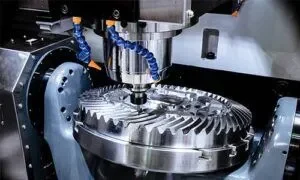A number of products today, from supersonic jets to smartphones, all are made of versatility and reliability of CNC milling. Before proceeding further, first understand the CNC and milling separately.
CNC Machine: CNC Machining is a process that delivers instruction to specific computer programs. It includes G-Code and helps to bring virtual samples into real ones. So basically, it produces finished materials from raw materials via different methods. CNC is totally based on computer programs and no manual operation is required.
Milling Machine: milling machines, on the other hand, help to cut and drill the materials (materials of any kind). Whether it works manually or is operated with CNC, it has a milling cutter held in a spindle; different in size and form. There are different kinds of milling machines…
- 2-axis milling machines
- 3-axis milling machines
- 4-axis milling machines
- 5-axis milling machines
CNC Milling Machine
CNC Milling Machine is operated through computers to resolve the latest trend of technology which are difficult to accomplish via old methods. For instance, achieving perfect car parts or even aerospace parts cannot be done without CNC milling machines. With the help of computer programs, everything can be accomplished.
It also lowers the cost of prototyping. It is used to produce large volumes and rapid Prototyping. Only not in industrial units, CNC milling machines are used, they have their roots in all fields of life including…
- cabinets
- furniture
- woodworking
- instruments
- aluminum machining
- prototyping and modeling
- sculpture
- signs
Besides these fields, CNC milling can cut a variety of materials and metals…
- aluminum
- steel
- titanium
- copper
- bronze
- zinc
- PVC
- nylon
- wood
- plywood
- extruded polyurethane
- stone
History Of CNC Milling
Its record can be traced out to the industrial revolution. The first CNC milling machine was created by Richard Kegg in 1952 with the help of MIT known as Cincinnati Milacron Hydrotel.
Apparently, the actual birth of this machine was 1958 when Richard filed a partition for “Motor Controlled Apparatus for Positioning Machine Tool”. Today’s CNC milling machines have developed with the latest trends.
But after 1972 CNC milling became popular across the globe due to the development of CAD (Computer-Aided Design) and CAM (Computer-Aided Machining). In 1989 finally, the CAD and CAM became standard for CNC milling.
Today’s CNC Industry
Today’s world seems incomplete without the use of CNC milling. Because it has approached all spheres of life, be it mobile devices, parts of alarm clocks, sunglasses, toothbrushes, dental implants, airplanes, cars, or parts or aerospace. It is faster, more accurate, and more precise than its prior models. It mill, cut, drill, nibble, and swivel with perfect and repeat accuracy. If there is no CNC machine obviously there would be no mobiles, cars, glasses, coffee machines, dental implants and airplanes. It increases productivity, minimizes down-times, and detects causes of failure quickly. Cool features, aren’t they?
Advantages of Using CNC Milling
Due to its extensive industrial usage, CNC milling has plenty of advantages for its users. Below are some of the many advantages of using CNC milling machines.
- High Precision Process
- Produces Parts with Accuracy
- Material Choice
- Least chances of human errors.
- It assures accurate cuts.
- Availability of customization.
- Can use multiple cutters.
- And perform multiple cuts simultaneously.
- Perfect for producing individual prototype
- Provide flexible computer control options
- Capable to produce complicated pieces
The CNC Milling Process
The process of CNC milling not only includes shaping but also holes, slots, pockets, and notches. The edge of the cutting tool makes several cuts in the product that are removed during the process.
The first phase of the CNC Milling starts when you feed the manufacturing instructions to the CAD system in 2D or 3D format. Once you complete the process, the machine takes it in its readability format and starts working in different ways on the chosen material.
But before commencing the first phase, you need to fit the machine with the right tools and need to fix the raw material with a vice. Once the preparation is completed, the operator launches the program into the computer by using the machine interface.
When the CNC Milling Process starts, the tool starts spinning at the speed of thousands of RPM. Machines can take the following actions to produce workpieces…
- Feed the workpiece slowly into stationary and rotating tooling
- Move the tool across the workpiece
- Move both the workpiece and tool combined.
CNC Milling Operations
CNC Milling is suitable for high accuracy, high tolerance parts in Prototyping, and tolerance ranging from +/- 0.001 in. to +/- 0.005. Even some milling machines can get the tolerance above the +/- 0.0005. The common CNC milling operations are…
- Face milling
- Plain milling
- Angular milling
- Form milling
Popular types of chips in CNC milling
There are different types of chips available for different workpieces, cutting conditions, and deformation within the cutting process. According to chip shape, chips are divided into four types which are popularly used in metal cutting. Chips are produced when you want to give the desired shape to your workpiece.
1. Continuous Chips
If the chips are formed without segments and breakages during machining then obviously it is known as continuous chip.
When there is minimum friction between the tool face and chip, and when ductile material with high cutting speed is Machined then continuous chips are formed.
Following conditions are responsible for continuous chips…
- Ductile material is used
- High cutting speed.
- Small depth of cut.
- Bigger rake angle
- Minimum friction between tool face and chip
Advantages
- Less heat generation
- Low power consumption.
- Long life of the tool due to less wear and tear.
- Better surface finish
2. Discontinuous Chips
If the chip is formed with breakage and segments during the machining process then it is not continuous, rather it is a discontinuous chip. Discontinuous Chips are produced when brittle and hard metals like bronze, cast iron, and brass are Machined.
Conditions that are responsible…
- Low feed rate.
- Small rake angle
- High cutting speed.
- High depth of cut
- High friction forces
- Low stiffness of machine tool
Advantages
- good surface finish
- increases the tool life
- reduces power consumption.
3. Continuous Chips with Built-Up Edge
Continuous Chips with Built-Up edges are similar to continuous chips but with less smoothness owing to built-up edges.
It is formed due to the high friction of ductile material.
Conditions that are responsible…
- Excessive feed rate.
- small rake angle
- Low cutting speed.
- Lack of coolant
Advantages
- protects the tool
- Generate high friction and temperature
- Extend the tool life
Non-homogenous chip (serrated chip)
Known as semi-continuous chips that are formed due to non-straight strain on the material while cutting. Its appearance is sawtooth-like owing to low and high shear strain. It is formed when mechanical strength of the material decreases by increasing temperature along with low thermal conductivity.
How much does CNC Milling cost?
There are a number of CNC milling machines in the market that you can hire for your project. And it all depends upon your job requirements and cost. Mainly there are two types of CNC machines which are 3-axis machines and multi-axis machines.
3-axis machines include a CNC milling machine and cost you around $40 per hour to work, on the other hand, CNC turning costs you around $35 per hour to operate. Moreover, sometimes machines’ costs increase due to the addition of operation costs. Multi-axis machines cost you around $70 to $120 per hour, material also affects cost.
Though CNC milling is an expensive process, we offer CNC milling services at a reasonable cost and help to meet the goal of our clients.
The cost Of popular plastic per sheet is as follows…
- ABS costs $17 per block
- POM (Delrin) costs $27 per block
- Nylon 6 costs $30 per block
Cost Of popular metals
- Aluminum 6061 costs $25 per block
- Aluminum 7075 costs $80 per block
- Stainless steel 304 costs $90 per block
Conclusion
To wrap the discussion up, CNC milling is a unique yet expensive process that brings the real shape of your prototype. We tried to deliver all essential information regarding CNC milling its different features, types, and cost. It has unique features and advantages that are obviously worth its cost. Don’t consider its cost, the prototype it will deliver will not let you regret.
We are an emerging company with years of experience in CNC Machining and milling and offer our services, not above your budget.
If you find anything missing just leave a comment in the comment section and if find it informative then do not forget to share!

